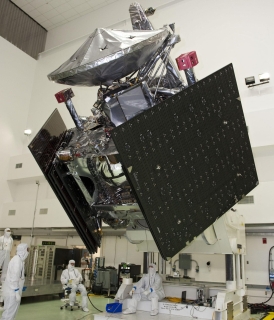Fifth out from the sun, Jupiter is the largest planet in the solar system, more than twice as massive as all the other planets combined. Jupiter's swirls are cold clouds of ammonia and water, floating in an atmosphere of hydrogen and helium. Jupiterís Great Red Spot is a giant storm bigger than Earth, that has existed for hundreds of years.
Jupiter orbits about 778 million kilometers, or 5.2 Astronomical Units (AU) from our Sun (Earth is one AU from the Sun). Jupiter rotates once every 10 hours, but takes about 12 Earth years to complete one orbit of the Sun.
Jupiter is a gas giant, so it has no Earth-like surface. If it has a solid core at all, itís probably only about the size of Earth.
Jupiter's atmosphere is made up mostly of hydrogen and helium. These are the elements that were in the solar system when it first formed, and also in the sun. Indeed, it is thought that Jupiter wasn't quite massive enough to collapse gravitationally and create enough heat and pressure to turn on nuclear fusion, to become a star. Jupiter cannot support life as we know it, but some of its moons have oceans beneath their crusts that might.
Jupiter has more than 75 moons. In 1979 the Voyager mission discovered Jupiterís faint ring system, on its way out of the solar system. All four giant planets in our solar system are now known to have ring systems. Nine spacecraft have visited Jupiter. Seven flew by, and two have orbited. Juno, the most recent, arrived at Jupiter in 2016.
The first large, amazing photos of the planet Jupiter were actually taken by the Cassini spacecraft in 2001, on its way to Saturn. Have a look at what Cassini showed us.
 In 2023, NASA's Juno is currently in orbit around Jupiter, exploring this giant world.
Juno is a solar-powered spacecraft making long, eccentric orbits around the planet. On a close flyby, passing less than 3,500 kilometers above the clouds, Juno had to stay out of Jupiterís shadow to avoid freezing. Juno has discovered, among other things, a giant cyclone at Jupiterís south pole.
In 2023, NASA's Juno is currently in orbit around Jupiter, exploring this giant world.
Juno is a solar-powered spacecraft making long, eccentric orbits around the planet. On a close flyby, passing less than 3,500 kilometers above the clouds, Juno had to stay out of Jupiterís shadow to avoid freezing. Juno has discovered, among other things, a giant cyclone at Jupiterís south pole.
Jupiterís Great Red Spot has been around for centuries, but it appears to be slowly shrinking, from twice Earthís size in 1979 to 1.3 times now. Juno examined its depths, showing that its roots are 320 kilometers deep, 50 to 100 times as deep as Earthís oceans.
The cloud bands we can see from Earth have an intricate structure up close. Near the equator, they penetrate into the deepest parts of Jupiterís atmosphere. But as you move closer to the poles, these belts tend to shift into other structures.
See a huge photo of Jupiter
The view of Jupiterís turbulent atmosphere that forms the title picture at the top of the page was taken by the Juno spacecraft. It includes several of the planetís southern jet streams. Evidence from Juno shows tat the jet streams and belts penetrate about 3,000 kilometers down into the planet. The storm known as the Great Red Spot is also visible on the upper horizon, nearly rotated out of view as Juno sped away from Jupiter at an incredible 48 kilometers per second, which is more than 160,900 kilometers per hour. At the time, the spacecraft was about 50,000 kilometers from the planetís cloud tops.
|

